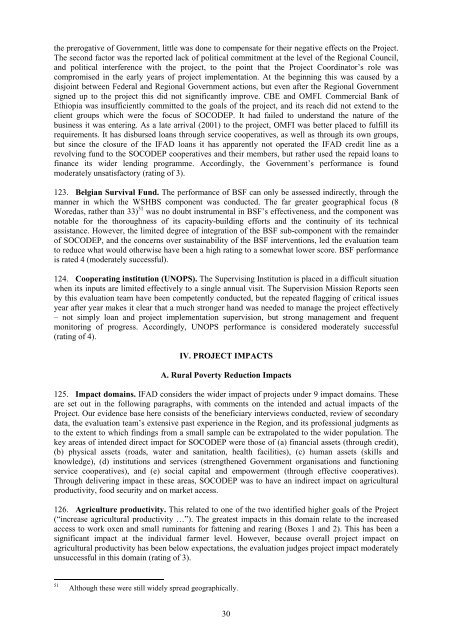Ethiopia SOCODEP CE - main report - IFAD
Ethiopia SOCODEP CE - main report - IFAD
Ethiopia SOCODEP CE - main report - IFAD
You also want an ePaper? Increase the reach of your titles
YUMPU automatically turns print PDFs into web optimized ePapers that Google loves.
the prerogative of Government, little was done to compensate for their negative effects on the Project.<br />
The second factor was the <strong>report</strong>ed lack of political commitment at the level of the Regional Council,<br />
and political interference with the project, to the point that the Project Coordinator’s role was<br />
compromised in the early years of project implementation. At the beginning this was caused by a<br />
disjoint between Federal and Regional Government actions, but even after the Regional Government<br />
signed up to the project this did not significantly improve. CBE and OMFI. Commercial Bank of<br />
<strong>Ethiopia</strong> was insufficiently committed to the goals of the project, and its reach did not extend to the<br />
client groups which were the focus of <strong>SOCODEP</strong>. It had failed to understand the nature of the<br />
business it was entering. As a late arrival (2001) to the project, OMFI was better placed to fulfill its<br />
requirements. It has disbursed loans through service cooperatives, as well as through its own groups,<br />
but since the closure of the <strong>IFAD</strong> loans it has apparently not operated the <strong>IFAD</strong> credit line as a<br />
revolving fund to the <strong>SOCODEP</strong> cooperatives and their members, but rather used the repaid loans to<br />
finance its wider lending programme. Accordingly, the Government’s performance is found<br />
moderately unsatisfactory (rating of 3).<br />
123. Belgian Survival Fund. The performance of BSF can only be assessed indirectly, through the<br />
manner in which the WSHBS component was conducted. The far greater geographical focus (8<br />
Woredas, rather than 33) 51 was no doubt instrumental in BSF’s effectiveness, and the component was<br />
notable for the thoroughness of its capacity-building efforts and the continuity of its technical<br />
assistance. However, the limited degree of integration of the BSF sub-component with the re<strong>main</strong>der<br />
of <strong>SOCODEP</strong>, and the concerns over sustainability of the BSF interventions, led the evaluation team<br />
to reduce what would otherwise have been a high rating to a somewhat lower score. BSF performance<br />
is rated 4 (moderately successful).<br />
124. Cooperating institution (UNOPS). The Supervising Institution is placed in a difficult situation<br />
when its inputs are limited effectively to a single annual visit. The Supervision Mission Reports seen<br />
by this evaluation team have been competently conducted, but the repeated flagging of critical issues<br />
year after year makes it clear that a much stronger hand was needed to manage the project effectively<br />
– not simply loan and project implementation supervision, but strong management and frequent<br />
monitoring of progress. Accordingly, UNOPS performance is considered moderately successful<br />
(rating of 4).<br />
IV. PROJECT IMPACTS<br />
A. Rural Poverty Reduction Impacts<br />
125. Impact do<strong>main</strong>s. <strong>IFAD</strong> considers the wider impact of projects under 9 impact do<strong>main</strong>s. These<br />
are set out in the following paragraphs, with comments on the intended and actual impacts of the<br />
Project. Our evidence base here consists of the beneficiary interviews conducted, review of secondary<br />
data, the evaluation team’s extensive past experience in the Region, and its professional judgments as<br />
to the extent to which findings from a small sample can be extrapolated to the wider population. The<br />
key areas of intended direct impact for <strong>SOCODEP</strong> were those of (a) financial assets (through credit),<br />
(b) physical assets (roads, water and sanitation, health facilities), (c) human assets (skills and<br />
knowledge), (d) institutions and services (strengthened Government organisations and functioning<br />
service cooperatives), and (e) social capital and empowerment (through effective cooperatives).<br />
Through delivering impact in these areas, <strong>SOCODEP</strong> was to have an indirect impact on agricultural<br />
productivity, food security and on market access.<br />
126. Agriculture productivity. This related to one of the two identified higher goals of the Project<br />
(“increase agricultural productivity …”). The greatest impacts in this do<strong>main</strong> relate to the increased<br />
access to work oxen and small ruminants for fattening and rearing (Boxes 1 and 2). This has been a<br />
significant impact at the individual farmer level. However, because overall project impact on<br />
agricultural productivity has been below expectations, the evaluation judges project impact moderately<br />
unsuccessful in this do<strong>main</strong> (rating of 3).<br />
51 Although these were still widely spread geographically.<br />
30

















